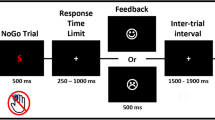Abstract
A group of 27 healthy young adults solved a task involving the working memory (WM) activation, consisting of the comparison between the spatial orientations of two sequentially presented square-wave luminance gratings. We investigated the effective (directed) connectivity patterns between the frontal and postcentral cortical regions related to the visual system. The connectivity was assessed using vector autoregression modeling of EEG. It was shown that the strength of the top-down right-hemispheric connectivity patterns directed from the frontal cortex to the visual areas in θ frequency was significantly lower at the stage of stimulus retention in the WM than at the stage of stimulus anticipation. On the contrary, in the α band the descending influences were slightly more intense. The results of the study showed the frequency-dependent dynamics of the descending influences of the frontal cortex on visual areas and confirm that the frontal cortex plays the role of a controlling and modulating center in the brain system underlying WM.


Similar content being viewed by others
REFERENCES
Miller, E.K., Lundqvist, M., and Bastos, A.M., Neuron, 2018, vol. 100, no. 2, pp. 463–475.
Friston, K.J., Brain Connect., 2011, vol. 1, no. 1, pp. 13–36.
Gazzaley, A. and Nobre, A.C., Trends Cogn. Sci., 2012, vol. 16.
Cosman, J.D., Lowe, K.A., Zinke, W., et al., Curr. Biol. CB, 2018, vol. 28, no. 3, pp. 414–420.
Squire, R.F., Noudoost, B., Schafer, R.J., et al., Annu. Rev. Neurosci., 2013, vol. 36, pp. 451–466.
Talalay, I., Kurgansky, A., and Machinskaya, R., Psychophysiology, 2018, vol. 55, e13269.
Fuster, J.M. and Alexander, G.E., Science, 1971, vol. 173, no. 3997, p. 652.
Sreenivasan, K.K. and D’Esposito, M., Nature Rev. Neurosci., 2019, vol. 20, no. 8, pp. 466–481.
Constantinidis, C., Funahashi, S., Lee, D., et al., J. Neurosci. Offic. J. Soc. Neurosci., 2018, vol. 38, no. 32, pp. 7020–7028.
Kurganskii, A.V., Zh. Vyssh. Nervn. Deyat. im. I.P. Pavlova, 2010, vol. 60, no. 6, p. 740.
Baccala, L., Sameshima, K., Ballester, G., et al., Appl. Sign. Proc., 1998, vol. 5, pp. 40–48.
Mikhailova, E.S., Gerasimenko, N.Yu., and Slavuts-kaya, A.V., Zh. Vyssh. Nervn. Deyat. im. I.P. Pavlova, 2019, vol. 69, no. 5, p. 578.
Gazzaley, A. and D’Esposito, M., in The Human Frontal Lobes, New York: Guilford Publications, 2006, 2nd edition, pp. 1–40.
Sauseng, P., Griesmayr, B., Freunberger, R., et al., Neurosci. Biobehav. Rev., 2010, vol. 34, no. 7, pp. 1015–1022.
Wianda, E. and Ross, B., Brain Behav., 2019, vol. 9, no. 4, e01263.
Bollinger, J., Rubens, M.T., Zanto, T.P., et al., J. Neurosci., 2010, vol. 30, no. 43, pp. 14399–14410.
Magnussen, S., Trends Neurosci., 2000, vol. 23, no. 6, pp. 247–251.
Sauseng, P., Hoppe, J., Klimesch, W., et al., Eur. J. Neurosci., 2007, vol. 25, pp. 587–593.
Palva, S. and Palva, J.M., Trends Neurosci., 2007, vol. 30, no. 4, pp. 150–158.
Fink, G.R., Halligan, P.W., Marshall, J.C., et al., Brain, 1997, vol. 120, p. 1779.
Berger, B., Griesmayr, B., Minarik, T., et al., Nature Commun., 2019, vol. 10, no. 1, p. 4242.
Funding
The study was partially financially supported by the grant of Russian Foundation for Basic Research no. 19-013-00918/19 and the state budget expenditures of the state task of the Ministry of Education and Science of the Russian Federation for 2021–2023. Electrophysiological tests were conducted in the Common Use Center for the Research Equipment of Functional Brain Mapping in the Institute of Higher Nervous Activity and Neurophysiology of the Russian Academy of Sciences.
Author information
Authors and Affiliations
Corresponding author
Ethics declarations
COMPLIANCE WITH ETHICAL STANDARDS
All participants signed an informed consent. The research protocol was approved by the ethical committee of Institute of Higher Nervous Activity and Neurophysiology of the Russian Academy of Sciences, protocol no. 1, January 15, 2020.
CONFLICT OF INTEREST
The authors declare that they have no conflicts of interest.
Additional information
Translated by E. Sherstyuk
Rights and permissions
About this article
Cite this article
Mikhailova, E.S., Kurgansky, A.V., Nushtaeva, R.A. et al. Intracortical Directed Connectivity for Information Retention in Visual–Spatial Working Memory. Dokl Biol Sci 500, 133–137 (2021). https://doi.org/10.1134/S0012496621050070
Received:
Revised:
Accepted:
Published:
Issue Date:
DOI: https://doi.org/10.1134/S0012496621050070




